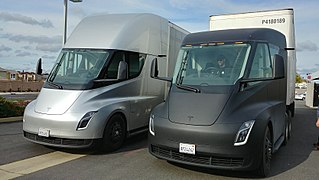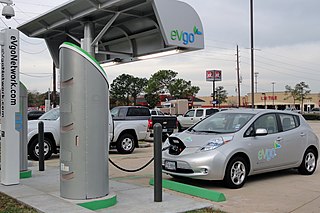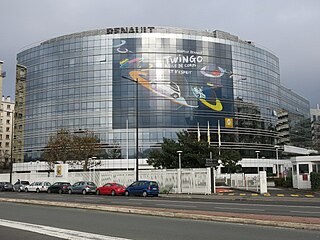
A hybrid vehicle uses two or more distinct types of power, such as internal combustion engine to drive an electric generator that powers an electric motor, e.g. in diesel-electric trains using diesel engines to drive an electric generator that powers an electric motor, and submarines that use diesels when surfaced and batteries when submerged. Other means to store energy include pressurized fluid in hydraulic hybrids.

An electric vehicle, also called an EV, uses one or more electric motors or traction motors for propulsion. An electric vehicle may be powered through a collector system by electricity from off-vehicle sources, or may be self-contained with a battery, solar panels or an electric generator to convert fuel to electricity. EVs include, but are not limited to, road and rail vehicles, surface and underwater vessels, electric aircraft and electric spacecraft.
Hybrid Synergy Drive (HSD) is the brand name of Toyota Motor Corporation for the hybrid car drive train technology used in vehicles with the Toyota and Lexus marques. First introduced on the Prius, the technology is an option on several other Toyota and Lexus vehicles and has been adapted for the electric drive system of the hydrogen-powered Mirai, and for a plug-in hybrid version of the Prius. Previously, Toyota also licensed its HSD technology to Nissan for use in its Nissan Altima Hybrid. Its parts supplier Aisin Seiki Co. offers similar hybrid transmissions to other car companies.

A genset trailer is a range extending device for use with battery electric vehicles consisting of an internal combustion engine and an electric generator. They run on traditional fuels such as gasoline or diesel and are sized to provide the continuous power requirements for the vehicle they are used with. Most small to midsized passenger vehicles would require 15 to 20 kW for unlimited freeway travel using fuel. Larger vehicles could require 30 kW (40 hp) or more of power depending on how heavy or un-aerodynamic they happen to be. This essentially converts an electric vehicle into a series-hybrid.
Blended mode is a charge-depleting mode of operation for plug-in hybrid electric vehicles (PHEVs) in which most of the motive energy is supplied by the battery pack but supplemented by the internal combustion engine (ICE). In contrast, all-electric or battery electric vehicles use only the electricity provided by the battery pack as their sole source of energy in a charge-depleting manner. Both types of advanced technology vehicles use regenerative brakes to recapture kinetic energy that should not be considered a fuel source but rather an efficiency aspect of these types of electric vehicle powertrains not found in traditional internal combustion engine vehicles.
Hybrid vehicle drivetrains transmit power to the driving wheels for hybrid vehicles. A hybrid vehicle has multiple forms of motive power.

The Chevrolet Volt is a plug-in hybrid car manufactured by General Motors, also marketed in rebadged variants as the Holden Volt in Australia and New Zealand, Buick Velite 5 in China, and with a different fascia as the Vauxhall Ampera in the United Kingdom and as the Opel Ampera in the remainder of Europe. Volt production ended in February 2019.
All-electric range (AER) is the driving range of a vehicle using only power from its electric battery pack to traverse a given driving cycle. In the case of a battery electric vehicle, it means the total range per charge. For a plug-in hybrid (PHEV), it means the range of the vehicle in charge-depleting mode. PHEVs can travel considerably further in charge-sustaining mode which uses both on-board fuel and the battery pack.
Cleanova are a set of plug-in hybrid vehicles by the Société de Véhicules Electriques (SVE), a joint venture between Dassault, Heuliez and Hydro-Québec. Cleanova II is based on Renault Kangoo. In January 2010, SVE has been taken over by Dow Kokam. In 2009 Dow Kokam received a $161 Million U.S. Department of Energy Grant for Next-Generation Battery Production for the hybrid and electric vehicle markets. The Michigan-based facility - Townsend Kokam Advanced Battery -is expected to produce enough batteries to supply 60,000 hybrid or electric vehicles per year. Three battery technologies are currently used in the cleanova: Li-Mn2O4, Li-FePO4, and Li-NiCoAl, with storage capacity adjustable to customer needs. Half the battery capacity can for instance be restored within 30 minutes.

Audi hybrid vehicles are hybrid electric vehicles created by the German carmaker, Audi. Some vehicles listed were concept vehicles, which utilised an internal combustion engine and an electric motor, and were used for research and development (R&D) for potential future use of the technology into possible series production. Audi launched its first hybrid concept car in 1989 called the Audi Duo, and was the first European company to sell a hybrid in 1997, though only in very small numbers.
Voltec, formerly known as E-Flex, is a General Motors powertrain released in November 2010. The Voltec architecture is primarily a plug-in capable, battery-dominant electric vehicle with additional fossil fuel powered series and parallel hybrid capabilities.

An electric-vehicle battery (EVB) or traction battery is a battery used to power the propulsion of battery electric vehicles (BEVs). Vehicle batteries are usually a secondary (rechargeable) battery. Traction batteries are used in forklifts, electric golf carts, riding floor scrubbers, electric motorcycles, electric cars, trucks, vans, and other electric vehicles.

An electric car is a plug-in electric automobile that is propelled by one or more electric motors, using energy typically stored in rechargeable batteries.

The BYD F3DM (Dual-mode) was a plug-in hybrid compact sedan manufactured by BYD with an all-electric range of 37 miles (60 km) and a hybrid electric powertrain that can extend the range an additional 300 miles (480 km). The F3DM is the world's first mass-produced plug-in hybrid automobile and went on sale to government agencies and corporations in China on December 15, 2008. During its first year in the market the F3DM plug-in sold only 48 vehicles. Sales to the general public began in Shenzhen in March 2010, and 417 units were sold during 2010. Cumulative sales in China reached 3,284 units through October 2013, when sales ended, and only 11 units were sold in Europe through October 2012.
Green Propulsion is a Belgian research and development centre specialising in battery electric and hybrid vehicles. The Imperia GP car is developed by Green Propulsion.

A range extender vehicle is a battery electric vehicle that includes an auxiliary power unit (APU) known as a 'range extender'. The range extender drives an electric generator which charges a battery which supplies the vehicle's electric motor with electricity. This arrangement is known as a series hybrid drivetrain. The most commonly used range extenders are internal combustion engines, but fuel-cells or other engine types can be used.

Range anxiety is the fear that a vehicle has insufficient range to reach its destination and would thus strand the vehicle's occupants. The term, which is primarily used in reference to battery electric vehicles (BEVs), is considered to be one of the major barriers to large scale adoption of all-electric cars. The term range anxiety was first reported in the press on September 1, 1997 in the San Diego Business Journal by Richard Acello referring to worries of GM EV1 electric car drivers. On July 6, 2010, General Motors filed to trademark the term, stating it was for the purpose of "promoting public awareness of electric vehicle capabilities". The Norwegian equivalent rekkeviddeangst was assigned second place in a list of Norwegian "words of the year" for 2013 by the Norwegian Language Council.

Hyundai Blue-Will is a plug-in petrol-electric hybrid concept compact car designed by the South Korean car manufacturer Hyundai Motor Company. The vehicle was debuted at the 2009 Seoul Motor Show in South Korea.

The Hyundai Ioniq is a compact five door liftback manufactured and marketed by Hyundai. The nameplate Ioniq is a portmanteau of ion and unique. It is the first automobile to be offered in hybrid, plug-in hybrid, and all-electric variants.













